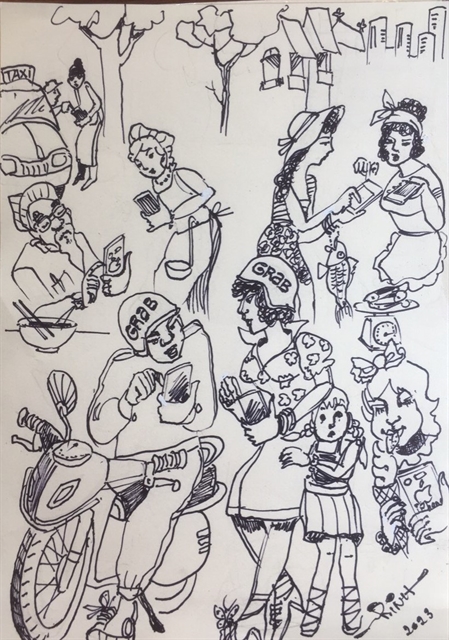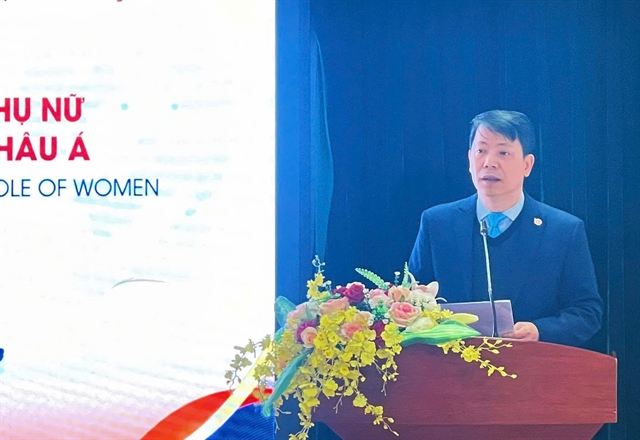 Talk Around Town
Talk Around Town


|
| Illustration by Trịnh Lập |
By Thanh Nga
Cashless payments have become a popular trend among Vietnamese people, with many increasingly opting to transfer funds or scan QR codes for both big and small transactions.
This trend has even spread to traditional wet markets.
According to Ngoãn, a trader selling vegetables at Trung Văn Market in Hà Đông District, Hà Nội, customers who buy vegetables worth just a few Vietnamese thousand đồng also want to transfer money, especially the young.
Ngoãn said that if she did not accept transfers, many customers would go elsewhere.
Thủy, who went to a small market in Thanh Oai District, didn't bring her wallet, only her smart phone. She bought two glutinous rice doughnuts for VNĐ7,000 [30 US cents] and transferred the money. She found the process convenient, as the seller had a QR code available, and it only took one or two seconds.
Thu, a cake seller, accepts all forms of payment, whether cash or transfer, as long as it's convenient for the customer. For Hoan, a florist at Tố Hữu Street, e-payment is more convenient, as it avoids confusion when receiving or returning change and eliminates worries about fake money.
The trend towards cashless payments is not just limited to urban areas, as more people in rural areas are also embracing e-payment methods.
HCM City’s Kim Hạnh said that even in Mũi Village in Ngọc Hiển District, the southernmost region of the country, the souvenir shop there accepted payments through bank transfer or QR code.
Similarly, Huệ, a shopper from Hà Nội, was able to buy items like hair dryers, electric fans, and suitcases without carrying cash during her trip to Quảng Ninh Province. The shop owners had a QR code available for customers to pay, even for small transactions like buying a hairpin for VNĐ10,000 [40 US cents].
According to Phạm Anh Tuấn, director of the Payment Department under the State Bank of Việt Nam, non-cash payment activities are now developing strongly. Consumers can see non-cash payments at supermarkets, restaurants, shops, markets, and even iced tea stalls on the street.
Tuấn said among cashless payment methods, QR codes had the strongest growth rate in both quantity and value, with the number of payments increasing by about 225 per cent in quantity and 243 per cent in value compared to the previous year.
One of the key drivers of the trend towards e-payments has been the growing popularity of mobile banking. Many Vietnamese consumers now use mobile banking apps to manage their finances, transfer money, and make payments. This has made it easier than ever for people to pay for goods and services using their mobile phones, without the need for cash or cards.
Another factor driving the trend towards e-payments in Việt Nam is the increasing availability of digital payment options. Today, there are a wide variety of digital payment options available in Việt Nam, including QR codes, mobile wallets, and online payment platforms. These platforms have made it much easier for consumers to make payments online, whether they are shopping online or paying bills or services.
In addition to these factors, the pandemic has also played a role in driving the trend towards cashless payments in Việt Nam. With social distancing measures in place, many consumers have been reluctant to use cash or visit physical stores. As a result, many have turned to digital payment methods as a safer and more convenient way to pay.
Despite the many benefits of cashless payments, however, there are still some challenges. One of these is the issue of security. While digital payment platforms are generally considered to be safe and secure, there is a risk of fraud or personal data breaches. To address these concerns, many payment providers have implemented strict security protocols and fraud prevention measures.
Challenges aside, the trend towards cashless payments in Việt Nam is on the rise steadily. As more consumers become comfortable with digital payment methods, and as more businesses begin to accept them, cashless payments will continue to grow in popularity. VNS




